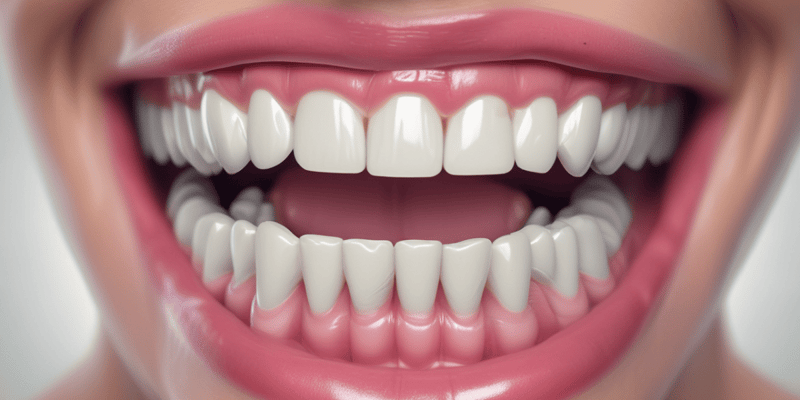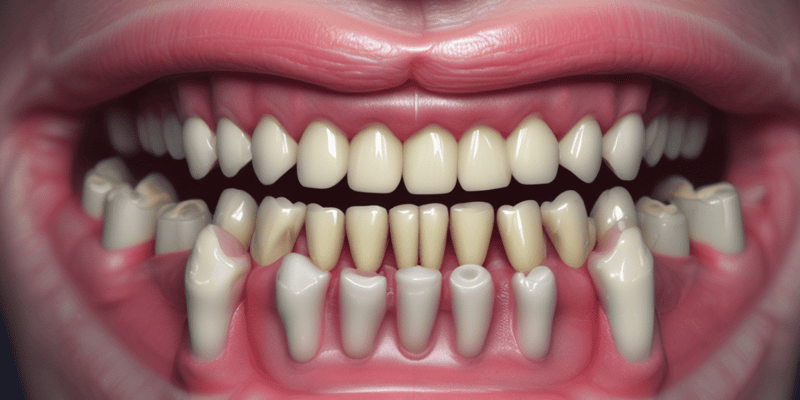Podcast
Questions and Answers
What is the most common dental injury for primary teeth in children?
What is the most common dental injury for primary teeth in children?
At what ages are children most commonly affected by upper incisor injuries?
At what ages are children most commonly affected by upper incisor injuries?
What characterizes an uncomplicated crown fracture in permanent dentitions?
What characterizes an uncomplicated crown fracture in permanent dentitions?
What type of injury involves displacement from its socket?
What type of injury involves displacement from its socket?
Signup and view all the answers
Which injury is primarily seen in permanent dentition?
Which injury is primarily seen in permanent dentition?
Signup and view all the answers
What type of dental injury is most prevalent in primary teeth?
What type of dental injury is most prevalent in primary teeth?
Signup and view all the answers
Which of the following age groups is least likely to sustain dento-alveolar injuries?
Which of the following age groups is least likely to sustain dento-alveolar injuries?
Signup and view all the answers
What differentiates an uncomplicated crown fracture from other injuries?
What differentiates an uncomplicated crown fracture from other injuries?
Signup and view all the answers
Which type of trauma involves disruption to the periodontal ligament but not avulsion?
Which type of trauma involves disruption to the periodontal ligament but not avulsion?
Signup and view all the answers
What is the most common dental injury seen in permanent dentition?
What is the most common dental injury seen in permanent dentition?
Signup and view all the answers
Study Notes
Dento-alveolar Injuries in Children
- Upper incisors are most frequently affected
- Primary teeth: Luxations are the most common injury
- Permanent teeth: Crown fractures are the most common injury
- Most common ages for dento-alveolar injuries: 2-4 years and 8-10 years
Predisposing Factors
- Age
- Lack of supervision
- Developmental stage
- Physical activity
- Environmental Factors
Extra-Oral Exam
- Soft tissue injury
- Facial asymmetry
- Swelling
Intra-Oral Exam
- Teeth position
- Mobility
- Occlusion
Radiographic Exam
- Periapical radiographs
- Occlusal radiographs
- Panoramic radiographs
Special Investigations
- Pulp vitality testing
- Radiographic assessment of pulpal health
- Computed tomography (CT)
Classification of Injuries
-
Primary Teeth:
- Luxation: Displacement of tooth from its socket
- Crown Fractures: Break in the enamel and dentin of the tooth
- Root Fractures: Break in the root of the tooth
- Avulsion: Complete displacement of the tooth from the socket
- Subluxation: Partial displacement of the tooth from its socket
- Intrusion: Tooth is forced into its socket
- Extrusion: Teeth are pushed out of their socket
-
Permanent Teeth:
-
Crown Fractures:
- Uncomplicated: No pulpal involvement
- Complicated: Pulpal involvement
-
Root Fractures:
- Vertical: Fracture runs along the long axis of the root
- Horizontal: Fracture runs perpendicular to the long axis of the root
-
Avulsion:
- Complete displacement of the tooth from the socket
- Can occur spontaneously
- Usually caused by trauma to the jaw
-
Crown Fractures:
Luxation Injuries in Permanent Teeth
- Displacement of the tooth from its socket
- Injuries can involve the following tissues:
- Periodontal ligament
- Alveolar Bone
- Soft tissues surrounding the tooth
- Several types of luxation:
- Extrusion: Tooth is pushed out of its socket
- Intrusion: Tooth is forced into its socket
- Lateral luxation: Tooth is displaced laterally
- Avulsion: Complete displacement of the tooth from its socket
Pulpal Protection in Crown Fractures
- Necessary to prevent pulpal death
- Methods include:
- Direct pulp capping: Placing a restorative material directly on the exposed dental pulp
- Indirect pulp capping: Placing a restorative material over the exposed dentin with time for the formation of a protective layer
- Pulpotomy: Removal of the coronal pulp to prevent infection of the remaining pulp
- Pulpectomy: Removal of the entire pulp
Dento-alveolar Injuries in Children
- Upper incisor teeth are most frequently affected by injuries.
- Primary teeth commonly suffer luxations (displacements)
- Permanent teeth typically experience crown fractures
- Most common age groups for these injuries are 2-4 years and 8-10 years old.
Primary Teeth Injuries
- Luxations are the most common type of injury in primary teeth.
Permanent Teeth Injuries
- Crown fractures are the most common type of injury in permanent teeth.
Predisposing Factors
- Age: Children between 2-4 years and 8-10 years are more susceptible.
- Activities: High-energy activities during these age groups increase injury risk.
- Location: Open spaces or areas with potential hazards increase injury risk.
Extra-oral Exam
- Observe for facial swelling, bruising, or lacerations: These signs may indicate an injury.
Intra-oral Exam
- Examine teeth for any signs of fracture, displacement, or mobility: Thoroughly check each tooth.
Radiographic Exam
- Periapical radiographs are essential for determining the extent and location of the injury.
- Occlusal radiographs may also be required for specific assessments.
Special Investigations
- Pulpal vitality testing may be performed: This determines if the tooth's nerve is still alive.
- Cone beam computed tomography (CBCT) may be considered for more complex cases.
- A dental specialist may be consulted for complex injuries.
Classification
- Ellis classification is commonly used to classify crown fractures.
- American Association of Endodontists (AAE) classification is used for luxation injuries.
Permanent Dentition Injuries
Crown Fractures
- Uncomplicated fractures involve no pulpal (nerve) involvement, which may need no treatment.
-
Pulpal involvement requires further assessment and treatment:
- Direct pulp capping may be used to protect the exposed nerve.
- Pulpotomy may be performed if the nerve is damaged.
- Pulpectomy may be necessary in severe pulpal necrosis.
Luxation Injuries
- Displacement from the socket: This is common in permanent teeth.
- Extrusion: The tooth is pushed out of its socket.
- Intrusion: The tooth is pushed into the bone.
- Lateral luxation: The tooth is moved to the side.
- Avulsion: The tooth is completely dislodged from its socket.
Tissues Involved
- Periodontal ligament, alveolar bone, and tooth enamel: These tissues are often affected by dento-alveolar injuries.
- Pulp (the nerve within the tooth) may also be involved.
Studying That Suits You
Use AI to generate personalized quizzes and flashcards to suit your learning preferences.
Related Documents
Description
This quiz covers the types and classification of dento-alveolar injuries commonly encountered in children, particularly focusing on upper incisors and the most frequent injuries to primary and permanent teeth. It also explores the predisposing factors, examination techniques, and necessary radiographic assessments related to these injuries.




